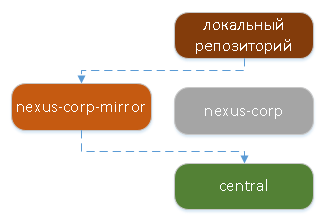どうなるの?
この記事には、設定の設定、pom、リポジトリでの検索の説明の例が含まれます。 ネクサス\アーティファクトの構成、それらに関連する問題はありません。
簡単なことから始めましょう
pomにspringの依存関係を追加します。
<dependency> <groupId>org.springframework</groupId> <artifactId>spring-webmvc</artifactId> <version>5.0.0.RELEASE</version> </dependency>
pom.xml
<project xmlns="http://maven.apache.org/POM/4.0.0" xmlns:xsi="http://www.w3.org/2001/XMLSchema-instance" xsi:schemaLocation="http://maven.apache.org/POM/4.0.0 http://maven.apache.org/maven-v4_0_0.xsd"> <modelVersion>4.0.0</modelVersion> <groupId>test</groupId> <artifactId>dependency-testing</artifactId> <version>1.0.0</version> <name>Dependency test</name> <dependencies> <dependency> <groupId>org.springframework</groupId> <artifactId>spring-webmvc</artifactId> <version>5.0.0.RELEASE</version> </dependency> </dependencies> </project>
Mavenをインストールしたばかりで、設定を変更しなかったとします。 Mavenアセンブリまたはideを介して依存関係検索を初期化した後、mavenは最初に
${user.home}/.m2/repository/
ディレクトリのローカルリポジトリにアーティファクトの存在を確認し
${user.home}/.m2/repository/
。
ローカルリポジトリにアーティファクトがない場合、リクエストは中央リポジトリに送られます。

このリポジトリは指定しませんでしたが、アセンブリ中にMavenによって常に追加されます。
settings.xmlを構成する
settings.xml
<?xml version="1.0" encoding="UTF-8"?> <settings xsi:schemaLocation="http://maven.apache.org/SETTINGS/1.0.0 http://maven.apache.org/xsd/settings-1.0.0.xsd" xmlns="http://maven.apache.org/SETTINGS/1.0.0" xmlns:xsi="http://www.w3.org/2001/XMLSchema-instance"> <profiles> <profile> <repositories> <repository> <id>nexus-corp</id> <name>nexus-corp-repo</name> <url>http://nexus.mycompany.com:8081/nexus/central/</url> </repository> </repositories> <id>nexus</id> </profile> </profiles> <activeProfiles> <activeProfile>nexus</activeProfile> </activeProfiles> </settings>
settings.xmlが必要なのはなぜですか?
この構成では、検索順序はデフォルトの構成に似ていますが、追加の手順が表示されます。 centralに進む前に、Mavenはnexus-corpリポジトリからアーティファクトをダウンロードしようとします。

鏡
nexus-corpリポジトリのミラーを追加します。
<mirror> <id>nexus-corp-mirror</id> <name>nexus-corp-mirror</name> <url>http://nexus.mirror.mycompany.com:8081/nexus/central/</url> <mirrorOf>nexus-corp</mirrorOf> </mirror>
いつミラーが必要ですか?
Mavenがnexus-corpリポジトリの検索ステップに到達すると、代わりにnexus-corp-mirrorリポジトリでアーティファクトを見つけようとします。
さらに、もし彼がnexus-corp-mirrorでそれを見つけなければ、 nexus-corpにはリクエストはありません。

また、ワイルドカードを使用してミラーを追加すると、他のミラーが指定されていない限り、すべての要求がそれに送信されます。
<mirror> <id>all</id> <name>nexus-corp-mirror</name> <url>http://nexus.mirror.mycompany.com:8081/nexus/central/</url> <mirrorOf>*</mirrorOf> </mirror>
検索順序
一般に、検索スキームは次のようになります。
1.ローカルリポジトリで検索する
2.優先順位を考慮して(またはそのミラーで)宣言の順にリポジトリを検索します
最後に、 セントラルが追加されます。 上書きされない限り、常に最後です。

構成のマージ
アセンブリを実行する前に、mavenは構成を「接着」します。
- グローバル-
${maven.home}/conf/settings.xml
- カスタム-
${user.home}/.m2/settings.xml
- プロジェクト
pom.xml
優先設定では、少し恥ずかしかった。 ドキュメントには、
前のsettings.xmlは、ユーザー設定とも呼ばれます。 両方のファイルが存在する場合、それらのコンテンツはマージされ、ユーザー固有のsettings.xmlが優先されます。実際、接着時に競合がなかった場合、リポジトリの優先順位は次のとおりで、降順です。
- グローバル
- 習慣
- pom.xml
以下の例から、順序は次のようになります。
- repo-global-setting1
- repo-user-setting1
- repo-user-setting2
- repo-pom1
- 中央
global-settings.xml
<?xml version="1.0" encoding="UTF-8"?> <settings xsi:schemaLocation="http://maven.apache.org/SETTINGS/1.0.0 http://maven.apache.org/xsd/settings-1.0.0.xsd" xmlns="http://maven.apache.org/SETTINGS/1.0.0" xmlns:xsi="http://www.w3.org/2001/XMLSchema-instance"> <profiles> <profile> <repositories> <repository> <id>repo-global-setting1</id> <url>http://nexus.mycompany.com:8081/nexus/repo-global-setting1-url/</url> </repository> </repositories> <id>g-nexus</id> </profile> </profiles> <activeProfiles> <activeProfile>g-nexus</activeProfile> </activeProfiles> </settings>
user-settings.xml
<?xml version="1.0" encoding="UTF-8"?> <settings xsi:schemaLocation="http://maven.apache.org/SETTINGS/1.0.0 http://maven.apache.org/xsd/settings-1.0.0.xsd" xmlns="http://maven.apache.org/SETTINGS/1.0.0" xmlns:xsi="http://www.w3.org/2001/XMLSchema-instance"> <profiles> <profile> <repositories> <repository> <id>repo-user-setting1</id> <url>http://nexus.mycompany.com:8081/nexus/repo-user-setting1-url/</url> </repository> <repository> <id>repo-user-setting2</id> <url>http://nexus.mycompany.com:8081/nexus/repo-user-setting2-url/</url> </repository> </repositories> <id>nexus</id> </profile> </profiles> <activeProfiles> <activeProfile>nexus</activeProfile> </activeProfiles> </settings>
pom.xml
<project xmlns="http://maven.apache.org/POM/4.0.0" xmlns:xsi="http://www.w3.org/2001/XMLSchema-instance" xsi:schemaLocation="http://maven.apache.org/POM/4.0.0 http://maven.apache.org/maven-v4_0_0.xsd"> <modelVersion>4.0.0</modelVersion> <groupId>test</groupId> <artifactId>dependency-testing</artifactId> <version>1.0.0</version> <name>Dependency test</name> <repositories> <repository> <id>repo-pom1</id> <url>http://nexus.mycompany.com:8081/nexus/repo-pom1-url/</url> </repository> </repositories> <dependencies> <dependency> <groupId>org.slf4j</groupId> <artifactId>slf4j-api</artifactId> <version>1.7.25</version> </dependency> </dependencies> </project>
紛争の解決により、さらに大きな誤解が生じました。 異なるプロファイルで1つのIDを持つリポジトリを宣言する場合、グローバル構成が優先されますが、同じIDを持つプロファイルを宣言する場合、ユーザーが優先されます。 私はもう実験し始めませんでした。
不足しているものを検索
エラーをどうするか
Could not resolve dependencies for project myproject:jar:1.0.0: Failed to collect dependencies at com.someproject:artifact-name:jar:1.0.0
か?
1.成果物の正しい名前とバージョンを確認します。
2.設定\ pomにリストされているリポジトリ\ミラーを確認します。
3.これらのリポジトリでアーティファクトを確認します
通常、問題は2番目のステップで解決されますが、これらのポイントに加えてプロキシによる問題もありますが、ダウンロードしたjarが破損することもあります(私自身は一度しか経験していませんが)。
スナップショットバージョンの場合、 -Uコマンドが便利です-スナップショットの依存関係を強制的に更新します。 デフォルトでは、mavenは1日1回タイムアウトが経過した後にのみそれらを更新します(パラメーターupdatePolicy)
キャスト
maven 3.5.0
jdk 1.8
debug maven